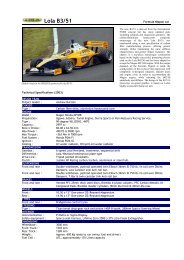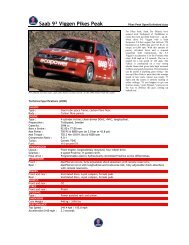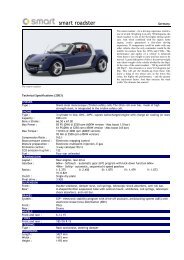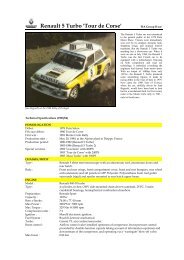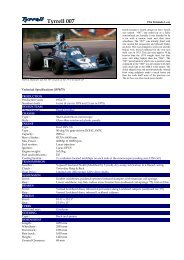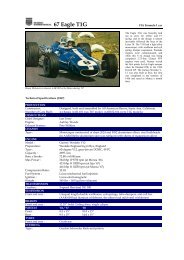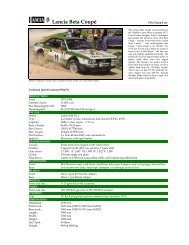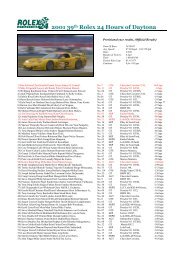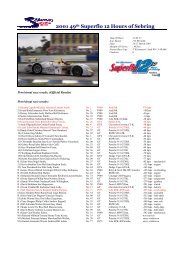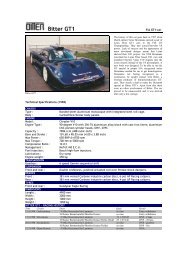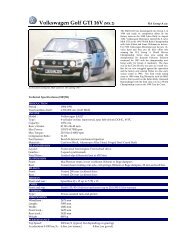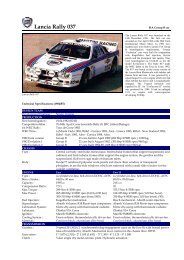70 Chaparral 2J - Motorsports Almanac
70 Chaparral 2J - Motorsports Almanac
70 Chaparral 2J - Motorsports Almanac
Create successful ePaper yourself
Turn your PDF publications into a flip-book with our unique Google optimized e-Paper software.
Kaser and from there, via the Canadians to the international group in Paris where they were accepted. Thus the<br />
American formula was made legitmate and the way was paved for the Canadian-American Challenge Cup series. While<br />
that fateful meeting of the CSI (Commission Sportif of the FIA) nailed it down, the rear engined G/7 cars were already<br />
beginning to thrive on North American race circuits. And the turing point had probably been the summer of 1963 at<br />
Continental Divide Raceways. With a United States Road Racing series already established, North American<br />
constructors were working hard at beating the Porsches with a combination British chassis and American stock block<br />
engine. Indianapolis great Roger Ward had appeared in a Cooper with a Buick engine in it as long ago as 1957, and<br />
Stirling Moss was the principal stockholder in California's Laguna Seca track with two wins in his Lotus 19-2.7 but his<br />
had a Coventry Climax engine. The real big bore engines, the everyday engines (much modified), had yet to make any<br />
impact. The chassis builders, including Roger Penske and the famous Zerex Special, were way ahead of the engine men.<br />
Then in August of '63 the USRRC at CDR turned the tide. Bob Holbert won it in a King Cobra, a Cooper-Ford with Bob<br />
Bondurant right behind in a similar car. Dave McDonald in a front-engine car was third. Chuck Daigh in a Cooper-<br />
Chevrolet was forth and the Porsches, driven by such accomplished drivers as Don Wester, were nowhere to be seen.<br />
That put the American Engine Solution in the limelight, and such things have been going in that direction ever since.<br />
The British, who were faced with a choice between Formula 2, a lesser version of F/1 and Group 7, decided to go with<br />
the open wheel cars - their pool of sponsors couldn't support both; and now they regret it. The Europeans who couldn't<br />
have been bothered have begun to take notice and for two years Ferrari has had a token respresentation in the Can-Am.<br />
This year he's serious. And no one would be particularly surprised if a Prosche showed - built to American Formula. It<br />
was a long struggle, but these days, Can-Am makes the going great.<br />
VIC ELFORD AND THE VACUUM CLEANER By Andrew S. Hartwell<br />
This article appeared in the "Through The Esses" column in All Race Magazine Issue 29.<br />
Among the many legends of motor racing there stands two men, working on opposite sides of the Atlantic ocean, who<br />
brought innovation to the race track time and again. In Europe, that man was Colin Chapman. His work with the Lotus<br />
Grand Prix cars saw radical changes with each new season and his cars were successfully campaigned by such<br />
legendary drivers as Jimmy Clark and Graham Hill. On the American side of the ocean, a tall Texas oilman and student<br />
of engineering by the name of Jim Hall was also bringing some innovative and radical thinking to the sportscar scene.<br />
His <strong>Chaparral</strong> creations were the first to introduce effectively designed air dams and spoilers ranging from the tabs<br />
attached to the earliest 2C model to the driver-controlled high wing 'flipper' on the astoundingly different looking 2E, all<br />
the way through to his most idealistically inspired creation, the <strong>2J</strong>. This is the car that would forever be known as the<br />
'vacuum cleaner'. Introduced in 19<strong>70</strong>, making its race debut at the Watkins Glen Can-Am race at the hands of world<br />
champion Jackie Stewart, the <strong>2J</strong> had no precedent to compare it to. It was an angular car at the front and just a big box<br />
at the back. And the back was a place that housed two large 17-inch fans driven by a JLO - Rockwell 45 hp snowmobile<br />
engine. The fans purpose was to literally 'suck' the air from under the car and shoot it out the back. They acted like<br />
reverse fans pulling air through and then out, thus giving the car amazing grip. The entire car was fitted with a 'skirt'<br />
made of a then-new material called Lexan. Plastic-like in construction, the skirt acted as a windbreak allowing the fans<br />
to pull out the air thus sucking the car onto the pavement. The amount of grip delivered by the twin fan units was so<br />
incredibly high that cornering speeds could be reached that no one else could ever hope to match in a more<br />
conventionally designed car. The <strong>2J</strong> represented both the latest in aerodynamic subterfuge and a threat to the sanctity of<br />
the motor racing establishment that existed at the time. It could really 'go' on the track, but there were those who just<br />
wanted it to 'go away'. The car only ran for one glorious season (19<strong>70</strong>) and like all new cars it had it's share of teething<br />
pains. Unfortunately it never had a chance to grow up as the sanctioning body, with more than a bit of prodding from<br />
the <strong>Chaparral</strong>'s competitors, decided to outlaw the technology after the season had ended. While the car had just one<br />
incomplete season of racing, it was fortunate to have had two outstanding drivers to race it. After Stewarts initial run,<br />
Englishman Vic Elford was hired to bring the car home with a win. Hall had said he needed to find someone who could<br />
handle the cornering power of his creation, as he didn't think he could do it himself. To best address his need for a<br />
qualified pilot he sought out Elford, who had established himself as one of the best in endurance racing with drives for<br />
Porsche at Le Mans and other venues. Elford was not able to bring the car a win in its maiden and final season but the<br />
road that leads to the podium was one 'Quick Vic' really enjoyed traveling on. I had a wonderful conversation with Vic<br />
Elford at the Porsche Rennsport Reunion at Lime Rock Park recently. I asked him to tell me of the '<strong>70</strong> season and his<br />
turn at the controls of the vacuum cleaner car. It is an interesting tale of speed, downforce, resentment and control.<br />
Eavesdrop for a minute. Vic Elford: "I was just trying to remember the first time I drove the <strong>Chaparral</strong> <strong>2J</strong> and I recall it<br />
was at Rattlesnake Raceway, Jim Hall's private track. He got me down there for a couple of days to get the feel for it<br />
because it was 'different' to drive. The first time I raced it was at Road Atlanta (in the Can-Am Championship) when I<br />
was about 2.5 seconds quicker than Denny (Hulme) for pole position. Then I drove it at Laguna Seca and again at<br />
Riverside. "Do you remember the old Riverside turn 9? It was a long, long, long fast 180-degree right-hander just before<br />
the pits. During practice I came up behind Denny (in the McLaren M8D-Chevrolet) on the way into that corner and it<br />
was a very fast corner. Not quite flat but for me very close to it, and I remember driving around the outside of Denny<br />
(laughing) and he just pulled off into the pit lane absolutely pissed off! He took his helmet off and sat on the pit wall<br />
and sulked for the rest of the practice session. I had beaten his time by about 2.5 seconds. It was a wonderful car to<br />
drive! Tell me about the cars automatic transmission: "It was a semi-automatic transmission, it wasn't fully automatic.<br />
It had a three-speed transmission with a torque converter and a lock-up at 5,000 rpm. It was quite complicated to get it<br />
running. The steering column went down between your two feet so the left foot could only work the brake and the right<br />
foot could only work the gas pedal. Was driving a car set up that way something of a shock to you? "By sheer luck,<br />
really, a year earlier I had a bad accident at the Nurburgring in the Grand Prix, which destroyed my shoulder. I was in



